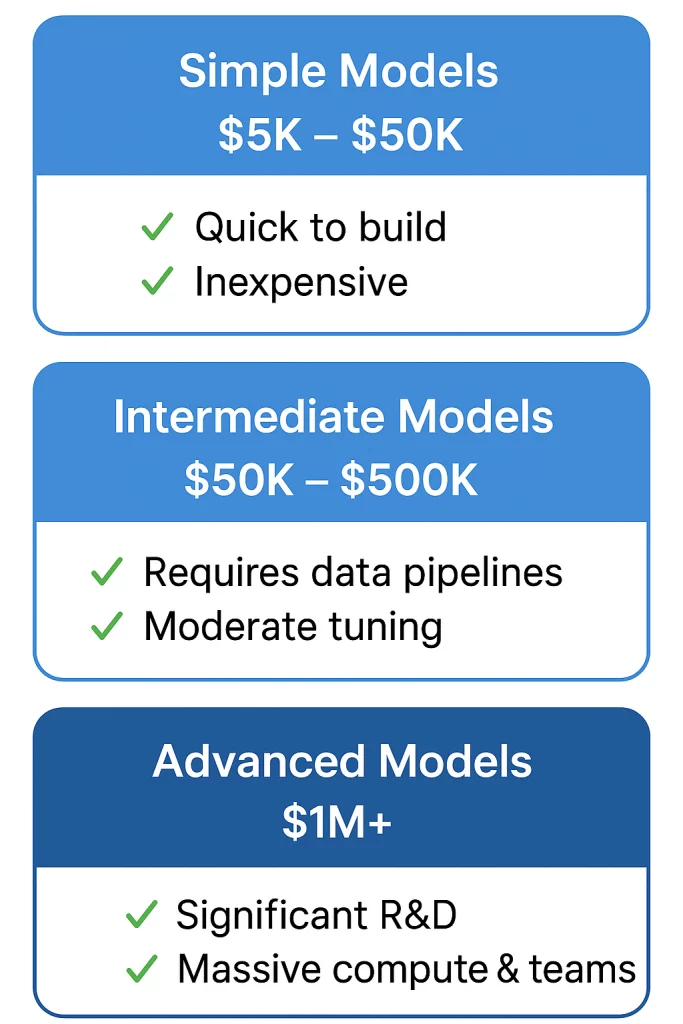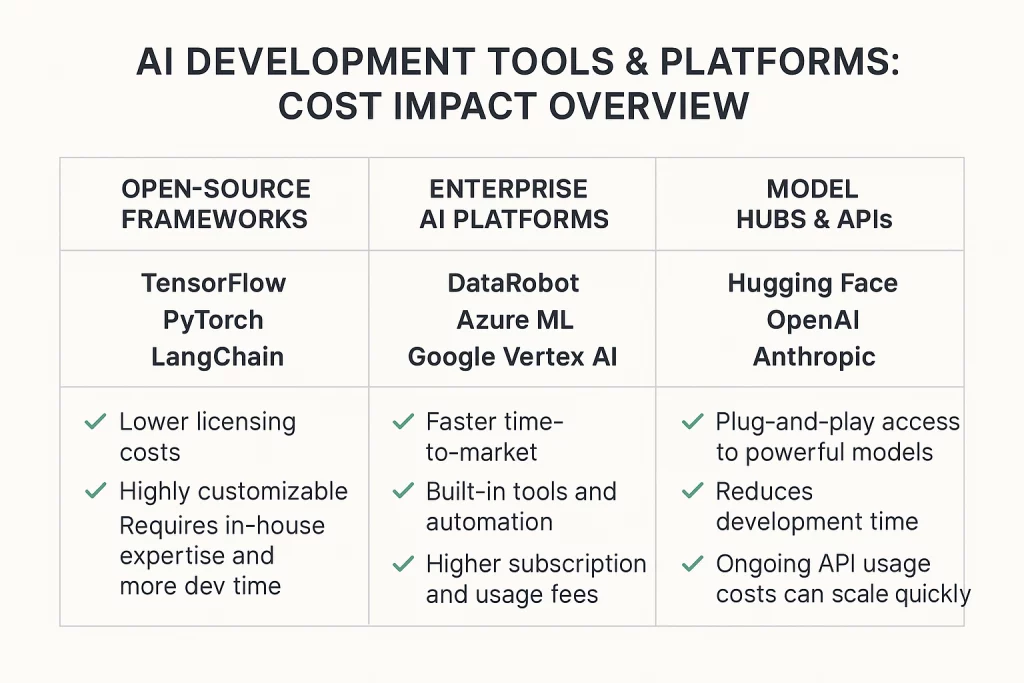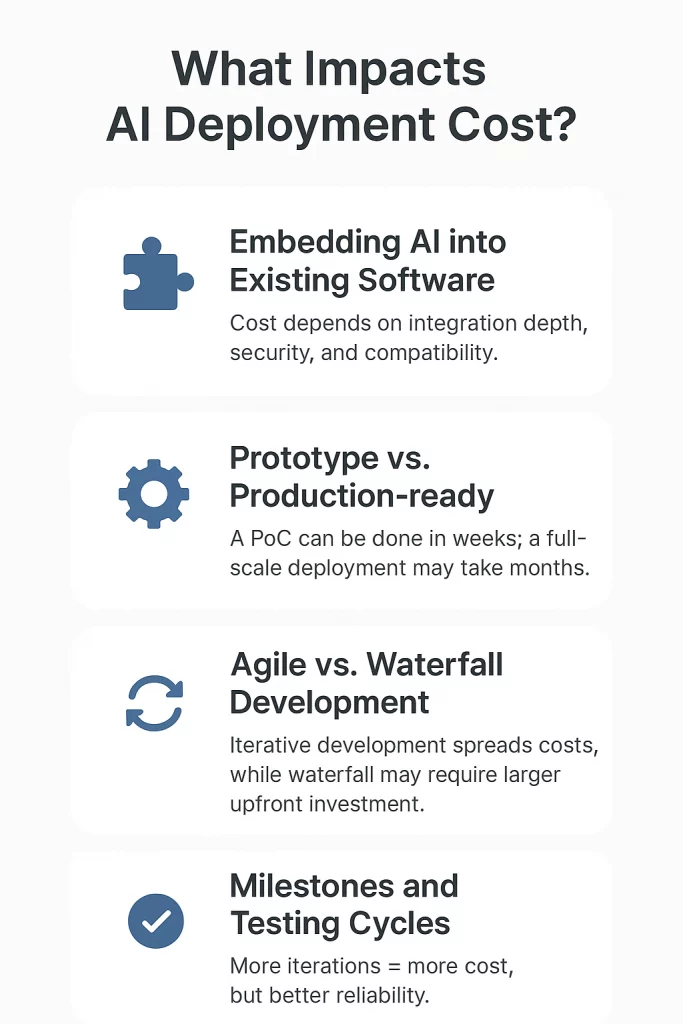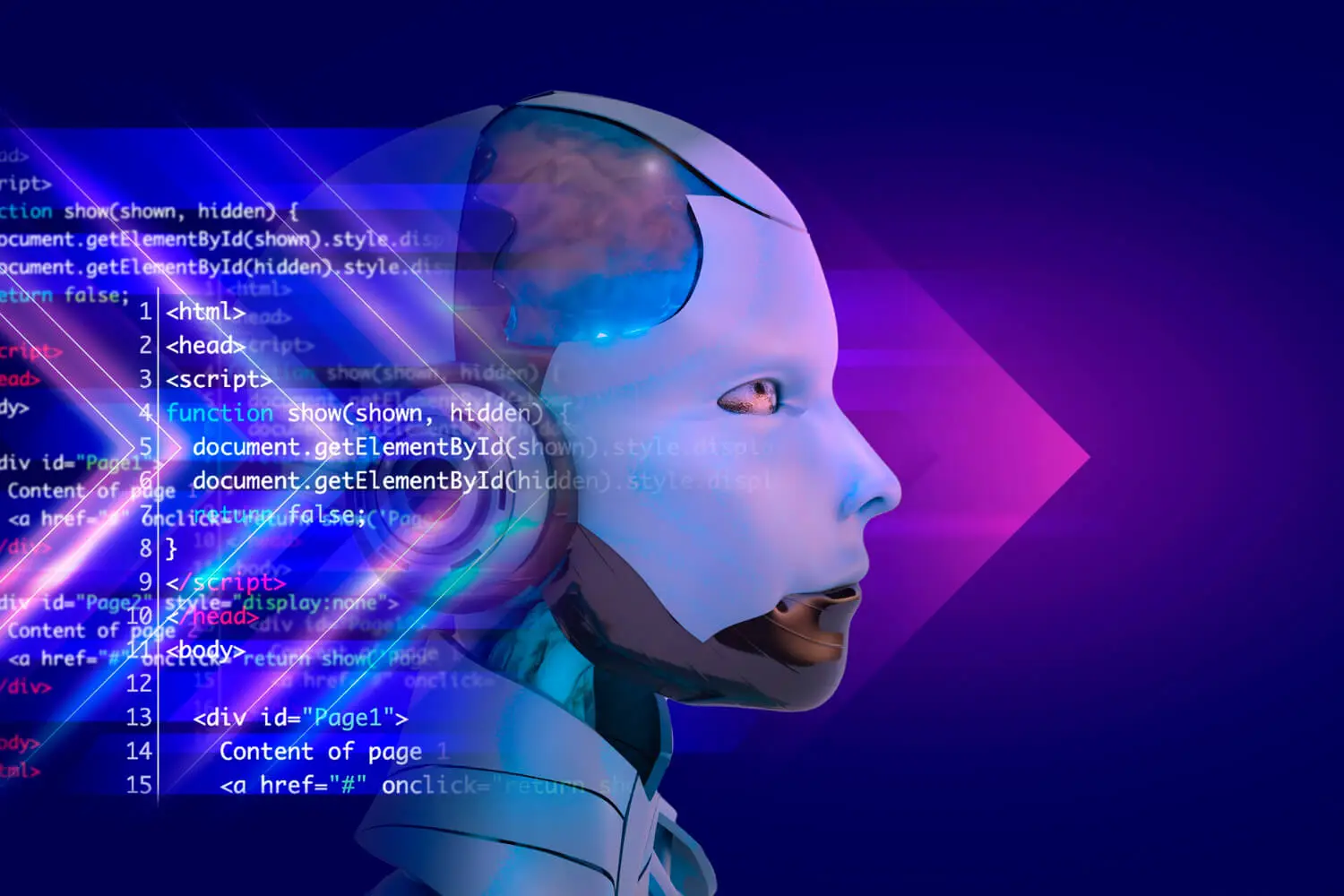Table of Contents
Listen to article
With AI powering everything from chatbots to analytics, companies are putting development at the top of their to-do list—and while it’s key to staying competitive, it also means rethinking their budgets and weighing new costs.
AI is a long-term investment. It boosts productivity, automates tasks, and cuts costs. But leaders still ask the million‑dollar question: how much does AI cost?
While we’d love to give you a straightforward answer, there isn’t one. Development, training, implementation, and integration all affect the cost of AI. There’s no one‑size‑fits‑all price tag.
But don’t worry, we’re here to break down the costs for different stakeholders—covering expenses such as training, integration, and ongoing maintenance—to give you a well-rounded understanding of what adopting AI truly means for your bottom line.
How Much Does AI Cost?
We all want to know: how much does it cost to build an AI system?
To help you understand the true cost of AI development, we’ve broken down the key cost factors:
Typical AI Cost Ranges
It’s hard to define a “typical” cost, as there are many factors that affect the overall price of custom AI solutions.
That said, to give you a general ballpark of what to expect, here’s a breakdown of average costs based on the complexity of your AI model:
- Low-complexity models: $5,000–$50,000
- Mid-complexity: $50,000–$500,000
- Advanced LLM-based systems: $500,000+
AI Training Costs
The cost of training AI models varies greatly depending on the approach. For traditional machine learning (ML) and deep learning (DL) models, companies bear the full cost of training—covering infrastructure, compute, and extensive data preparation, which can be significant.
On the other hand, generative AI models are rarely trained from scratch due to the immense resources required; instead, most businesses fine‑tune pre‑trained models, which is far more cost‑efficient.
Factors like infrastructure and data preparation still affect the overall AI software development cost, but the scale differs based on whether you’re building ML/DL models or fine‑tuning Gen AI.
Infrastructure Requirements:
We can’t talk about AI development costs without addressing key infrastructure considerations:
- Cloud compute vs. on-premises: Cloud providers typically use consumption‑based pricing—covering compute, storage, and network—which can become more expensive than on‑prem solutions at very high usage levels. However, cloud is usually the better starting point for most projects: it’s faster to deploy, easier to scale, and lets you monitor costs before committing to a long‑term setup. On‑premises, on the other hand, can make sense for companies investing in AI research or building generative AI models from scratch, where large‑scale token usage justifies the upfront investment. It’s also preferred when strict data protection or custom firewall setups are required, though it comes with higher maintenance overhead.
- GPUs and TPUs: Training AI models often requires specialized hardware like GPUs and TPUs—each with pricing that varies by model and cloud provider. For example, a P4d instance with NVIDIA A100 GPUs can cost around $32.77 per hour, while a G5 instance with NVIDIA A10G GPUs is roughly $1.19 per hour, making it a more cost‑efficient choice for mid‑sized workloads. Cloud TPU pricing varies depending on the product, deployment model, and region.
- Data storage and processing: Data storage and processing can significantly impact AI costs, especially with large volumes of unstructured data. To reduce unnecessary spending, your development partner can help you choose the right storage tier and optimize data flows.
Data Preparation
Here’s what you should know about data preparation for AI models:
- Data collection, labeling, and cleansing: Gathering and cleaning relevant data can be costly. Bad data leads to losses, inefficiencies, and reputational damage. That’s why data prep is a critical investment in AI training. Several factors influence the cost of data sourcing, including geographical location, use case complexity, and the choice of data vendors.
- Third-party datasets vs. proprietary: Third-party datasets can reduce development time but often involve licensing fees and usage limits. Proprietary data requires more effort to collect and clean but can improve model performance and lower long-term costs.
- Cost of annotation: Data annotation can be a major cost driver in AI projects. Manual labeling offers higher accuracy for complex tasks and is often required in specialized domains like medical data, but it’s time‑consuming and expensive. Automated annotation is faster and cheaper but may require human review to ensure quality—especially for nuanced data.
Training Cost Examples
Investments in training vary widely based on the model type and scale. LLM fine-tuning costs can start as low as $1,000, especially when using pre-trained models like GPT on cloud platforms.
Meanwhile, training models like image recognition systems from scratch can be far more expensive—and building large-scale models can run into the millions.
AI Implementation & Integration Costs
So what affects the cost of AI implementation?
Several factors must be considered, including infrastructure integration, frontend integration, and security requirements. With AI integration consulting, your business can navigate these complexities more effectively and avoid costly missteps.
Backend and Infrastructure Integration
AI models don’t work in isolation—they need to be connected to your existing systems. This means they should be integrated with databases, data pipelines, authentication systems, and cloud infrastructure.
Costs can increase if your backend isn’t designed to support real-time inference, handle large-scale data input, or meet AI-specific compute demands. For instance, real-time inference, as used in chatbots, autonomous vehicles, and fraud detection, requires low‑latency, always‑available resources, which can significantly raise operational costs.
Batch inference—commonly applied to document analysis, financial reporting, and content moderation—relies on scheduled, high‑throughput resources, offering greater cost efficiency.
Frontend/UI Integration
Integrating AI into the frontend can increase overall AI software costs, especially when the user experience requires complex interactions or real-time responses. Custom UI components, real-time data rendering, and responsive design for AI features like chatbots, recommendations, and dashboards all require additional development time.
And since every industry is different, these variations can significantly impact integration complexity and overall cost.
Security, Privacy & Compliance
Ensuring AI systems meet security standards and comply with AI laws—like GDPR and HIPAA—can raise costs. Data protection, access controls, and audits often need extra investment—especially in regulated industries.
That said, this is a necessary investment, as failing to meet these standards can lead to serious legal, financial, and reputational risks.
Ongoing AI Operational & Maintenance Costs
AI development isn’t a one-and-done expense—it requires ongoing maintenance to ensure optimal performance.
Monitoring & Retraining
AI models require ongoing monitoring to ensure they perform accurately over time. Changes in user behavior, data drift, or evolving business needs may require periodic retraining.
These efforts add to long-term costs, as they involve data updates, re-evaluation, and potential adjustments to infrastructure and workflows. However, the investment associated with monitoring and retraining is generally small compared to initial development—and it helps protect that value over time.
Infrastructure & Cloud Hosting
Over time, infrastructure and cloud hosting can become a significant part of your AI system’s total cost of ownership. While cloud platforms allow you to scale quickly, ongoing compute, storage, and data transfer fees can add up—especially for models running continuously or processing large volumes of data.
Monitoring usage and optimizing workloads are key strategies for keeping long-term hosting costs manageable.
Support & DevOps
Ongoing support and DevOps are essential for keeping AI systems stable and scalable. Tasks like deployment, monitoring, and updates add to long-term costs but help prevent downtime and performance issues.
Ready to build smarter and spend wiser? Our AI consulting experts help you avoid surprise costs—book a free consultation.

What Drives the AI Development Cost?
When exploring generative AI in software development, understanding the factors that influence cost is crucial. From the type of AI model to regulatory requirements, several elements can significantly impact your budget.
Type and Complexity of the AI Model
What type of AI model does your company require?
As you can see in the image below, this plays a huge role in the cost of your AI solution.

AI Data Requirements
Data is fundamental to the development of AI. And for the same reason, your project’s data requirements affect the cost of your solution. Here’s how:
- Availability: Is the data readily accessible, or does it need to be collected?
- Volume: Larger datasets increase storage and processing expenses.
- Quality: High-quality, labeled data is costly to obtain or annotate.
- Processing: Cleaning, transforming, and augmenting data adds time—and raises development costs.
AI Development Team Composition
Varying skill sets, team size, and whether the team is in-house or outsourced all affect the cost of developing AI.
- In-house vs. outsourced: In-house AI development gives you full control but comes with high upfront costs—hiring talent, maintaining infrastructure, and managing ongoing operations. Outsourcing, on the other hand, offers access to experienced teams and faster turnaround, often at a lower cost. The right choice depends on your budget, timeline, and internal capabilities.
- Expertise required: AI development requires a multidisciplinary team, which directly impacts cost. Data scientists and ML engineers handle model training and evaluation, while AI/ML architects design scalable solutions. Frontend and backend engineers are needed for deployment and integration, and project managers and experienced AI consulting companies ensure alignment with business goals. The more specialized the expertise, the higher the development cost.
Tooling & AI Frameworks
Let’s take a look at how common AI development tools compare:

AI Infrastructure and Compute Needs
So what do you need to know about AI infrastructure?
We’ve narrowed down the key cost considerations:
- Local development vs. cloud-based compute: Local development offers lower recurring expenses since compute power relies on existing infrastructure, but it may be limited in scalability and require upfront investment in hardware. Cloud-based compute solutions—like AWS, GCP, or Azure—offer virtually unlimited scalability and flexibility, but costs can rise quickly with large-scale training workloads, ongoing usage, and data transfer fees.
- Training environment: Training AI models on high performance hardware like GPUs or TPUs can significantly accelerate development. However, these resources come at a high cost, especially during long training cycles for large models, making careful budget planning and resource optimization essential throughout the AI life cycle.
- Storage: Storage is a critical cost factor for AI projects, particularly those involving image, video, or multimodal data, which can consume vast amounts of space. High-performance and scalable storage solutions are essential to ensure efficient data access during training and inference, but they can also drive up long-term costs depending on volume, redundancy, and retrieval frequency.
- CI/CD pipelines: CI/CD pipelines streamline model training and deployment but come with added infrastructure and AI maintenance costs. While they boost efficiency and reliability, they also require investment in tools and ongoing upkeep.
AI Integration & Project Scope
There are various factors that impact AI integration and deployment costs:

AI Regulatory and Compliance Requirements
Regulated industries like healthcare, finance, and government agencies place added demands on AI in software development, requiring features such as explainable AI, data anonymization, and audit trails. These compliance measures increase development complexity, timeline, and cost.
AI Cost Efficiency Analysis
While it’s important to understand the cost of implementing AI, it’s just as crucial to weigh it against the long-term value it brings. Keep reading as we break down custom vs. off-the-shelf solutions, compare AI to traditional automation, and explore the real impact AI can have on your business.
Custom AI vs. Off-the-Shelf Solutions
The key difference between custom AI and off-the-shelf solutions often comes down to cost—off-the-shelf tools are more affordable upfront, while custom AI requires a higher investment but offers greater flexibility and scalability.
- Price range for off-the-shelf tools: Off-the-shelf AI tools like ChatGPT API, Jasper, and similar platforms typically follow usage-based or subscription pricing models. For example, the ChatGPT API uses a pay-per-token model, while Jasper and other SaaS tools typically offer tiered monthly plans that scale with features and team size.
- Custom AI development: Custom AI development costs depend on the use case and complexity. Simple ML models are more affordable, while generative models require more time and resources. For example, AI in web development can range from basic chatbots to advanced personalization or predictive tools.
AI vs. Traditional Automation
AI often requires a higher initial investment than traditional automation, but it typically yields greater long-term ROI. While traditional tools automate fixed tasks, AI—like contact center AI—adapts over time, reducing labor costs, minimizing errors, and improving customer satisfaction.
One study found that using AI-driven forecasting in supply chain management can cut errors by 20% to 50%, reducing lost sales and product shortages by up to 65%.
AI Value Beyond Dollars
Businesses that adopt AI don’t just cut costs—they gain a competitive advantage and faster innovation. By embracing AI technologies, companies can deliver hyper-personalized experiences, streamline content creation, and respond to customer needs in real time.
From smart recommendations to dynamic pricing, AI doesn’t just boost efficiency—it gives your brand that extra spark that keeps customers interested.
Main Strategies & Techniques for AI Cost Optimization
There are several effective strategies for AI cost reduction that help businesses minimize expenses without sacrificing performance or innovation:
- Start small with an AI MVP (Minimum Viable Product): Begin with a focused, low-risk solution that solves a specific problem. This lets you validate impact and ROI before investing in full-scale development. With 42% of startups failing due to a lack of market need, developing an MVP helps ensure your AI solution addresses real user pain points before scaling.
- Leverage pre-trained AI models & APIs: Using tools like ChatGPT API or Google Vision saves time and money. These models are production-ready and eliminate the need for building from scratch.
- Use open-source AI frameworks and model libraries: Frameworks like TensorFlow, PyTorch, and Hugging Face offer powerful tools for free. They speed up development and reduce licensing costs.
- Optimize data acquisition & labeling: Focus on collecting only the most relevant data and use semi-automated or outsourced labeling to cut costs. Quality over quantity reduces both time and compute.
- Choose cloud services strategically: Pick cloud providers and pricing plans based on your project’s size and scale. Using spot instances or auto-scaling features can significantly lower compute expenses.
- Monitor usage & performance continuously: Track system usage, model performance, and cost metrics in real time. This helps prevent resource waste and enables early optimizations.
- Outsource wisely: Partner with an experienced AI development company to avoid in-house overhead. Look for those with proven cost-efficient delivery and industry-specific knowledge.
How to Successfully Plan for the AI Development Costs for Your Industry?
AI development costs vary depending on your industry’s complexity, compliance needs, and the level of customization required. Here’s a closer look at what to expect across different sectors:
- AI costs in e-commerce: In e-commerce, AI is often used for product recommendations, personalized shopping experiences, dynamic pricing, and inventory forecasting. Development costs typically range from $20,000 to $150,000+, depending on whether you’re customizing existing models or building from scratch. Leveraging generative AI in e-commerce can drive higher conversion rates but may require deeper integration and content training.
- AI costs in healthcare: Due to data privacy regulations and the need for highly accurate results, AI in healthcare—such as diagnostic tools or predictive patient analytics—can range from $50,000 to $250,000+. Costs also factor in HIPAA compliance, secure data handling, and system interoperability.
- AI costs in finance: Financial institutions use AI for fraud detection, risk modeling, customer insights, and algorithmic trading. Costs can range from $50,000 to $250,000+, depending on data infrastructure, security requirements, and the complexity of real-time decision systems and AI legal assistants.
- AI costs in customer support: AI-driven customer support tools—like chatbots and AI business assistants—generally cost between $20,000 and $100,000+. Using pre-trained models can reduce development time and budget, especially for companies focused on scalability and multilingual support.
- AI costs in HR tech: In HR, AI is commonly applied to resume screening, candidate matching, performance tracking, and predictive hiring. Projects typically fall between $25,000 and $100,000+, with cost varying based on data integration, bias mitigation features, and reporting needs.
Pricing Models for AI Development
Choosing the right pricing model can greatly affect your overall software development cost. Here’s a quick look at the most common models used in AI development and when to use each.
Fixed-Price Model
A fixed-price model is a pricing structure where the cost of a project is agreed upon upfront, regardless of the time or resources required to complete it.
Best for:
- Well-defined projects with clear requirements and scope (such as simple chatbots or classification models).
How it works:
- A single flat fee is agreed upon before the project starts.
- Milestones and delivery timelines are fixed.
- Any change in scope typically results in a change order and additional fees.
Pros:
- Predictable budgeting
- Low risk for clients with tight specs
Cons:
- Inflexible for evolving projects
- May lead to rushed or minimal viable delivery if scope expands
Time and Materials (T&M) Model
The Time and Materials (T&M) model is a pricing approach where clients pay based on the actual time spent and resources used during the development process.
Best for:
- Evolving or exploratory AI projects (such as R&D, LLM integration, or experimentation with datasets).
How it works:
- Clients pay for the time and effort of the development team (hourly/daily/monthly rates).
- Cost depends on the actual usage of developer hours and tools.
Pros:
- High flexibility and adaptability
- Encourages agile development and iteration
Cons:
- Less cost predictability
- Requires active management and oversight
Milestone-Based Pricing
Milestone-based pricing is a model where payments are tied to the completion of predefined project phases or deliverables, providing transparency and accountability throughout the development process.
Best for:
- Projects with medium complexity and clear functional stages (such as data collection, model training, or deployment).
How it works:
- Payments are made upon the successful completion of predefined deliverables or phases.
Pros:
- Aligns progress with payments
- Reduces risk for both parties
Cons:
- Delays in one milestone may stall the entire project
- Scope creep can complicate milestone definitions
Subscription / Retainer Model
The subscription or retainer model is a pricing approach where clients pay a recurring fee for ongoing access to development resources, support, or maintenance over a set period.
Best for:
- Ongoing AI support, monitoring, maintenance, or continuous model improvement.
How it works:
- A recurring monthly or quarterly fee covers access to a dedicated team or support resources.
Pros:
- Smooth, long-term collaboration
- Budgeting becomes easier over time
Cons:
- May not be suitable for short-term projects
- Underutilization risk if tasks are sporadic
Revenue Share or Performance-Based Pricing
Revenue share, or performance-based pricing, is a model where payment is tied to the success of the project, such as a percentage of generated revenue or results achieved.
Best for:
- High-risk/high-reward AI partnerships, especially in startups or experimental solutions.
How it works:
- The service provider takes a lower (or zero) upfront fee in exchange for a percentage of future revenue or success metrics (such as conversion rate improvement or sales uplift).
Pros:
- Aligns incentives
- Reduces upfront costs
Cons:
- Complex contracts and legal oversight
- Requires high trust and transparent metrics
Pay-Per-Use (for AI APIs and Services)
Pay-per-use is a pricing model where clients are charged based on actual usage of AI APIs or services, such as the number of API calls, tokens processed, or compute time consumed.
Best for:
- Cloud AI services like image analysis, speech-to-text, or LLMs.
How it works:
- You’re charged based on actual usage (such as number of API calls, tokens processed, or inference time).
Pros:
- Very scalable and startup-friendly
- No need to build or maintain complex infrastructure
Cons:
- Costs can escalate quickly with scale
- Dependency on external services
Hybrid Models
Hybrid models combine two or more pricing approaches—such as fixed price for initial planning and T&M for ongoing development—to offer flexibility and cost control throughout the project lifecycle.
Best for:
- Complex enterprise projects that require flexibility and long-term support.
How it works:
- Combines elements of fixed price (for foundational work), T&M (for research), and subscription (for maintenance).
Pros:
- Balanced risk-sharing
- Highly customizable to project needs
Cons:
- More complex to negotiate and manage
- Requires clear boundaries between models
Our Expertise in AI Development
As an experienced AI development company, we create custom solutions that help you overcome unique challenges, drive innovation, and achieve long-term business growth through intelligent automation and expert AI software engineering.
And what’s more, we don’t just focus on innovation—we leverage advanced technologies and smart development strategies to improve AI cost efficiency. Our AI consulting services guide you through every stage, from planning and feasibility to execution and optimization.
Below, we’ve provided links to some of our favorite projects so you can get to know our work.
Akillion
Our team developed an AI virtual assistant that increases data management efficiency.
OrthoSelect
We developed 3D modeling software that improves accuracy in orthodontic treatments.
Codeaid
We developed an advanced coding test platform that streamlines recruitment processes.
Conclusion and Key Takeaways
Understanding your AI development cost is essential to building effective, scalable solutions. From choosing the right pricing model to aligning with industry-specific needs, smart planning helps you maximize ROI and avoid unexpected expenses.
At Scopic, we combine innovation with cost efficiency to deliver AI solutions tailored to your business. From assessing your AI readiness and managing AI liability to launching an MVP, we’re here to help you turn your ideas into an impactful solution.
Join leading businesses already transforming operations with Scopic’s AI solutions to cut costs and accelerate growth. Book your free consultation today and see what’s possible for your project.
FAQs about AI Development Cost
How much does it cost to build a custom AI system from scratch?
AI app development costs vary based on project complexity, data requirements, and industry-specific needs. Low-complexity models typically range from $5,000 to $50,000, while advanced LLM-based systems can exceed $500,000.
Can small businesses afford AI development costs?
Yes, small businesses can afford AI development by starting with focused solutions and leveraging AI cost optimization strategies. When paired with smart planning, using pre-trained models and MVP approaches can help keep both AI and web development costs manageable.
What’s the difference in cost between using a pre-trained model and training my own?
Using a pre-trained model is far more cost-effective, but training your own—while significantly more expensive—offers greater control, customization, and performance tailored to your specific use case.
How much do AI APIs cost?
AI APIs typically use a pay-per-use pricing model, with costs ranging from a fraction of a cent to several dollars per request, depending on the service and usage volume.
Are there hidden or ongoing AI costs in development projects?
Yes, AI development often comes with ongoing or hidden costs like cloud hosting, model retraining, data storage, and maintenance. Working with an experienced AI development company can help clarify these expenses upfront and ensure you’re prepared for long-term success.
How long does it take to implement an AI solution?
The timeline to implement an AI solution can range from a few weeks to over a year, depending on the project’s complexity, data availability, and integration needs.
Is AI more cost-effective than traditional automation?
Yes, AI is often more cost-effective than traditional automation in the long run. While it may require a higher upfront investment, AI’s ability to learn, adapt, and handle complex tasks leads to greater efficiency, scalability, and long-term ROI.
Can open-source AI tools reduce costs?
Yes, open-source AI tools can significantly reduce development costs by eliminating licensing fees and accelerating the development process. They also offer flexibility for customization, making them a cost-effective option for many businesses.

About AI Development Costs Guide
This guide was authored by Baily Ramsey, and reviewed by Enedia Oshafi, Engineering Operations Manager at Scopic.
Scopic provides quality and informative content, powered by our deep-rooted expertise in software development. Our team of content writers and experts have great knowledge in the latest software technologies, allowing them to break down even the most complex topics in the field. They also know how to tackle topics from a wide range of industries, capture their essence, and deliver valuable content across all digital platforms.
Note: This blog’s images are sourced from Freepik.





